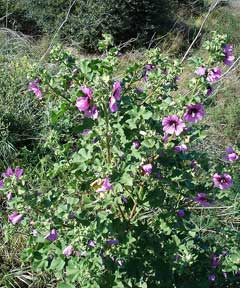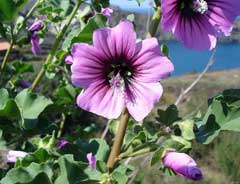 |
|
http://commons.wikimedia.org/wiki/User:Jeantosti |
 |
| http://commons.wikimedia.org/wiki/User:Jeantosti |
Translate this page:
Summary
Physical Characteristics

 Lavatera is a BIENNIAL growing to 3 m (9ft) by 0.5 m (1ft 8in) at a fast rate.
Lavatera is a BIENNIAL growing to 3 m (9ft) by 0.5 m (1ft 8in) at a fast rate.
It is not frost tender. It is in flower from July to September. The species is hermaphrodite (has both male and female organs) and is pollinated by Insects.
Suitable for: light (sandy), medium (loamy) and heavy (clay) soils and prefers well-drained soil. Suitable pH: mildly acid, neutral and basic (mildly alkaline) soils. It cannot grow in the shade. It prefers dry or moist soil. The plant can tolerate maritime exposure.
UK Hardiness Map
US Hardiness Map
Synonyms
Plant Habitats
Edible Uses
Young leaves - raw or cooked. A mild flavour, but the leaves are dry and hairy and not that agreeable in quantity on their own[K]. They can be used as part of a chopped mixed salad[K].
References More on Edible Uses
Medicinal Uses
Plants For A Future can not take any responsibility for any adverse effects from the use of plants. Always seek advice from a professional before using a plant medicinally.
A poultice made from the leaves is used to treat sprains[4].
References More on Medicinal Uses
The Bookshop: Edible Plant Books
Our Latest books on Perennial Plants For Food Forests and Permaculture Gardens in paperback or digital formats.

Edible Tropical Plants
Food Forest Plants for Hotter Conditions: 250+ Plants For Tropical Food Forests & Permaculture Gardens.
More

Edible Temperate Plants
Plants for Your Food Forest: 500 Plants for Temperate Food Forests & Permaculture Gardens.
More

More Books
PFAF have eight books available in paperback and digital formats. Browse the shop for more information.
Shop Now
Other Uses
References More on Other Uses
Cultivation details
An easily grown plant, succeeding in any ordinary garden soil in sun or partial shade[1, 187]. Prefers a light well-drained moderately fertile soil in full sun[200]. A soil that is too rich encourages foliar growth at the expense of flowering[200]. Tolerates maritime exposure[200]. Plants are very fast-growing and often flower in their first year from seed[200]. They flower so freely in their second year that they normally die afterwards, though they sometimes perennate[200]. When well sited, this species usually self-sows freely[200]. There are some named forms developed for their ornamental value[200].
References Carbon Farming Information and Carbon Sequestration Information
Temperature Converter
Type a value in the Celsius field to convert the value to Fahrenheit:
Fahrenheit:
The PFAF Bookshop
Plants For A Future have a number of books available in paperback and digital form. Book titles include Edible Plants, Edible Perennials, Edible Trees,Edible Shrubs, Woodland Gardening, and Temperate Food Forest Plants. Our new book is Food Forest Plants For Hotter Conditions (Tropical and Sub-Tropical).
Shop Now
Plant Propagation
Seed - sow late summer in situ[200]. The seed should germinate within 4 weeks.
Other Names
If available other names are mentioned here
Native Range
EUROPE: United Kingdom, Ireland, Albania, Greece (incl. Crete), Croatia, Italy (incl. Sardinia, Sicily), Montenegro, Spain (incl. Baleares), France (incl. Corsica), Portugal AFRICA: Spain (Canarias), Portugal (Madeira Islands), Algeria (north), Tunisia
Weed Potential
Right plant wrong place. We are currently updating this section.
Please note that a plant may be invasive in one area but may not in your area so it’s worth checking.
Conservation Status
IUCN Red List of Threatened Plants Status :

Growth: S = slow M = medium F = fast. Soil: L = light (sandy) M = medium H = heavy (clay). pH: A = acid N = neutral B = basic (alkaline). Shade: F = full shade S = semi-shade N = no shade. Moisture: D = dry M = Moist We = wet Wa = water.
Expert comment
Author
L.
Botanical References
17200
Links / References
For a list of references used on this page please go here
Readers comment
| Add a comment |
|
If you have important information about this plant that may help other users please add a comment or link below. Only comments or links that are felt to be directly relevant to a plant will be included. If you think a comment/link or information contained on this page is inaccurate or misleading we would welcome your feedback at [email protected]. If you have questions about a plant please use the Forum on this website as we do not have the resources to answer questions ourselves.
* Please note: the comments by website users are not necessarily those held by PFAF and may give misleading or inaccurate information.
To leave a comment please Register or login here All comments need to be approved so will not appear immediately.
|
|